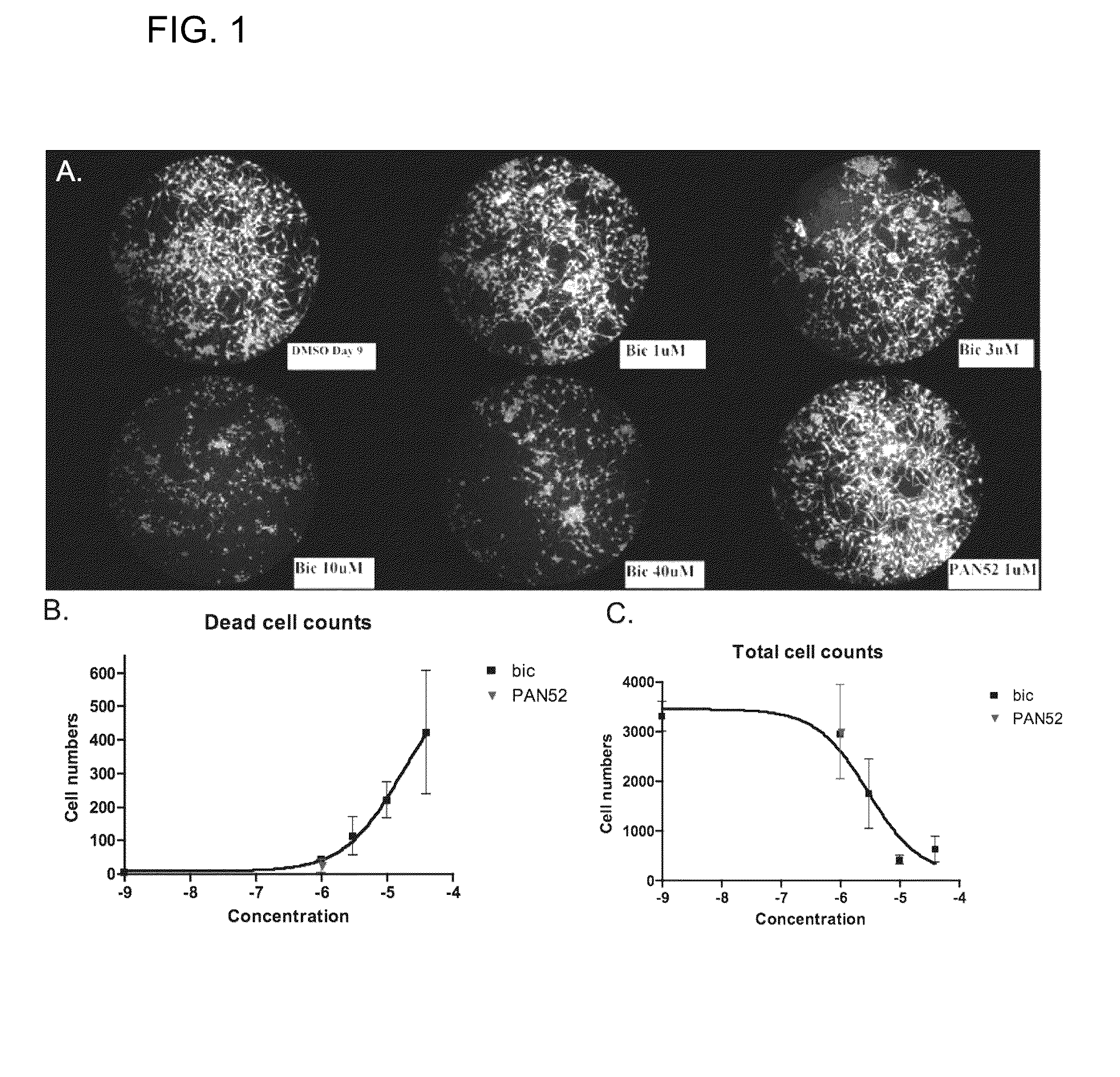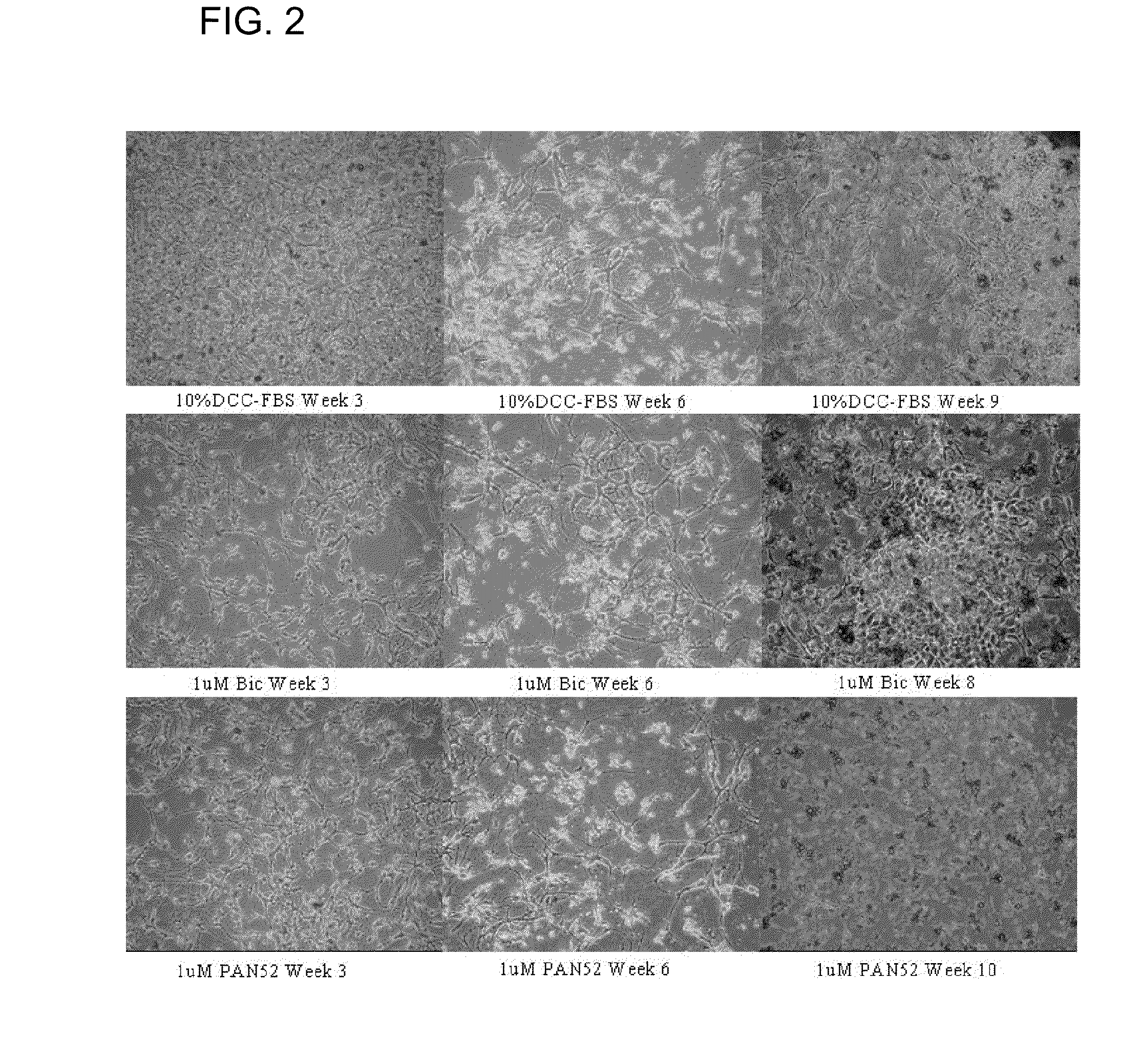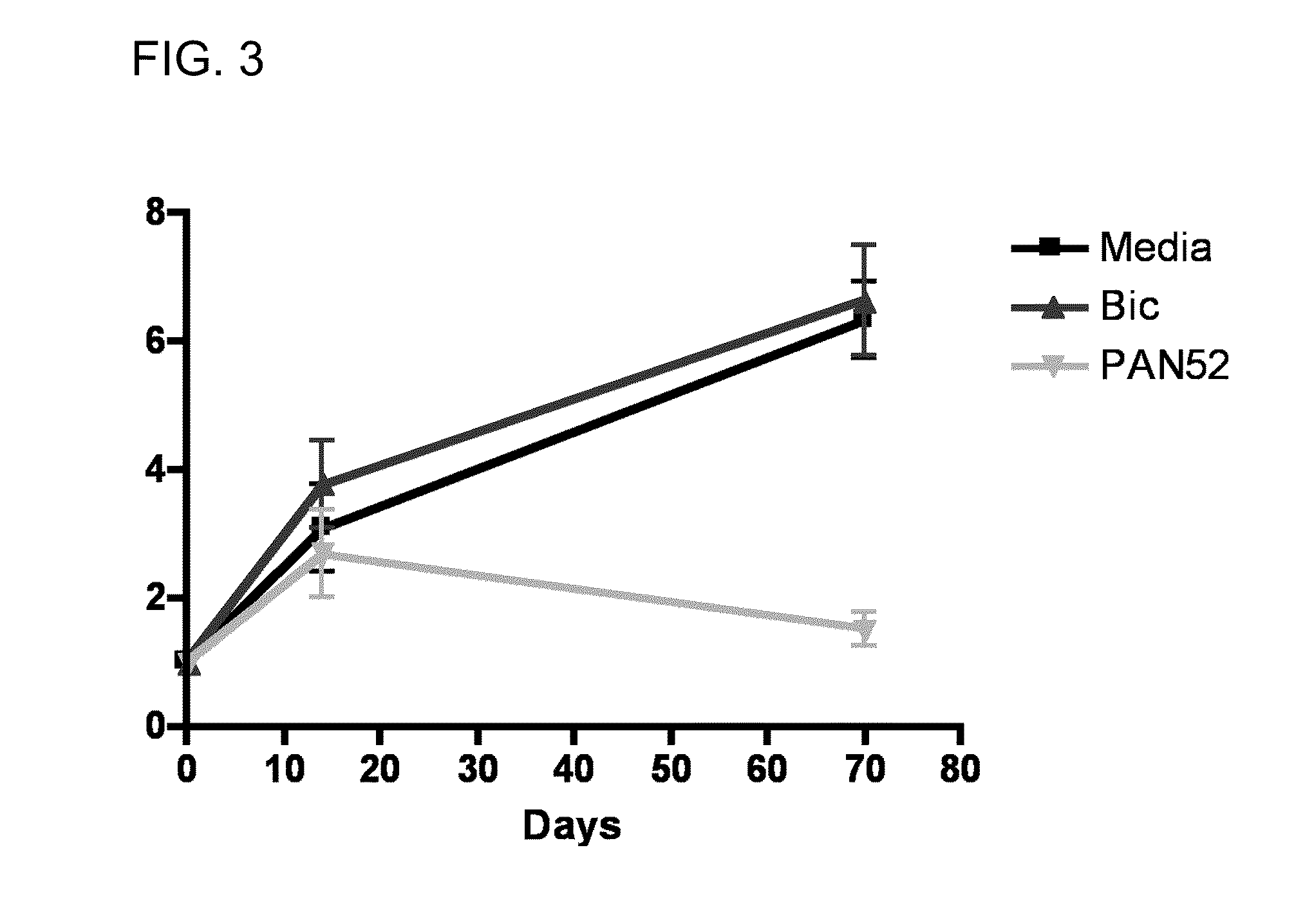Pan-antagonists for the androgen receptor and androgen receptor mutants associated with anti-androgen withdrawal
an androgen receptor and mutant technology, applied in the field of anti-androgen withdrawal, can solve problems such as clinical failure, and achieve the effect of reducing androgen receptor overexpression and reducing androgen receptor expression in the cell
- Summary
- Abstract
- Description
- Claims
- Application Information
AI Technical Summary
Benefits of technology
Problems solved by technology
Method used
Image
Examples
example 1
N-(4-cyano-3-(trifluoromethyl)phenyl)-3-(2′-(3-(dimethylamino)propoxy)biphenyl-2-ylsulfonyl)-2-hydroxy-2-methylpropanamide PAN42 (Formula XIII)
[0083]25 mg (50 μmol) PAN11 (see FIG. 10 for structure), 42 mg (129 μmol) anhydrous cesium carbonate and 8 mg (50 μmol) 3-dimethylaminopropylchloride hydrochloride were mixed in 1 ml anhydrous DMF (dimethylformamide). The reaction mixture was stirred under nitrogen overnight. After reaction the mixture was extracted with ethyl acetate. The organic layer was separated, washed with water, brine and dried over magnesium sulfate, filtered and evaporated. The crude oil was partially refined by silica chromatography followed by purification by C4 HPLC (0.3 ml / min, acetonitrile / 0.01% TFA water solution). HPLC separation yield 5.2 mg PAN42 (8.8 μmol, 17% yield). 13C NMR (101 MHz, MeOD) δ 175.25, 158.09, 144.05, 143.11, 139.66, 137.01, 134.89, 132.47, 131.86, 131.42, 129.47, 128.60, 127.59, 124.11, 121.86, 119.08, 117.70, 116.71, 112.59, 104.78, 101.4...
example 2
Pan52 was Synthesized from (2-bromophenyl)(2,4,6-trimethoxybenzyl)sulfane
[0084]To a solution of (2-bromophenyl)(2,4,6-trimethoxybenzyl)sulfane 1.37 g (3.7 mmol) and 2-isopropoxy-4,4,5,5-tetramethyl-1,3,2-dioxaborolane 700 mg (3.7 mmol) in 37 ml THF at −78° C., was added dropwise 6.2 ml (7.4 mmol) of 1.2 M t-butyllithium. The reaction was allowed to stir at −78° C. for 45 min, before NH4Cl was added and the resulting mixture extracted with ethyl ether (3× 15 ml). The organic layer was washed with brine (3× 15 ml) dried over MgSO4 and concentrated in vacuo. The product, 4,4,5,5-tetramethyl-2-(2-(2,4,6-trimethoxybenzylthio)phenyl)-1,3,2-dioxaborolane, was crystallized from ether 0.8 g (52% yield) and was used in next reaction without further purification. 1H NMR (400 MHz, C6D6) δ 1.34 (s, 12H), 3.7 (s, 6H), 3.8 (s, 3H), 4.14 (s, 2H), 6.08 (s, 2H), 7.09-7.13 (m, 1H), 7.21-7.29 (m, 1H), 7.37-7.39 (m, 1H), 7.59 (m, 1H); 13C NMR (100 MHz, C6D6) δ24.8, 27.6, 55.3, 55.7, 83.84, 90.5, 106.9, ...
example 3
[0089]PAN62 (Formula X) is made in a similar procedure as PAN42:
[0090]13C NMR (101 MHz, MeOD) δ 174.95, 160.42, 144.00, 143.24, 140.65, 137.00, 134.33, 134.31, 132.78, 132.29, 129.86, 128.68, 125.33, 124.12, 122.61, 119.05, 119.00, 116.72, 114.80, 104.80, 74.54, 67.03, 63.28, 57.32, 45.18, 27.81, 27.66. 1H NMR (400 MHz, MeOD) δ 8.10 (s, 1H), 7.95-7.77 (m, 3H), 7.49 (t, J=7.1, 1H), 7.32-7.18 (m, 4H), 6.75 (d, J=8.5, 2H), 3.89 (d, J=6.4, 2H), 3.43-3.47 (m, 3H), 3.00 (d, J=14.8, 1H), 2.86 (s, 6H), 1.79 (d, J=6.4, 2H), 1
[0091]PAN12 (Formula V) is made in a similar procedure as PAN42
[0092]1H NMR (400 MHz, MeOD) δ 7.97 (d, J=1.8, 1H), 7.93 (d, J=8.0, 1H), 7.76 (dd, J=1.8, 8.5, 1H), 7.66 (d, J=8.5, 1H), 7.36 (t, J=7.6, 1H), 7.21-7.05 (m, 4H), 6.86 (dd, J=7.7, 14.2, 2H), 4.37 (q, J=16.5, 2H), 4.21 (d, J=14.6, 1H), 3.81-3.64 (m, 3H), 3.41 (d, J=6.3, 2H), 2.95 (s, 6H), 1.82 (d, J=6.3, 2H), 1.55 (s, 3H). 13C NMR (101 MHz, CDCl3) δ 175.25, 158.09, 144.05, 143.11, 140.05, 137.01, 134.96, 133.69,...
PUM
| Property | Measurement | Unit |
|---|---|---|
| pH | aaaaa | aaaaa |
| pharmaceutical composition | aaaaa | aaaaa |
| anti-androgen resistance | aaaaa | aaaaa |
Abstract
Description
Claims
Application Information
 Login to View More
Login to View More - R&D
- Intellectual Property
- Life Sciences
- Materials
- Tech Scout
- Unparalleled Data Quality
- Higher Quality Content
- 60% Fewer Hallucinations
Browse by: Latest US Patents, China's latest patents, Technical Efficacy Thesaurus, Application Domain, Technology Topic, Popular Technical Reports.
© 2025 PatSnap. All rights reserved.Legal|Privacy policy|Modern Slavery Act Transparency Statement|Sitemap|About US| Contact US: help@patsnap.com



